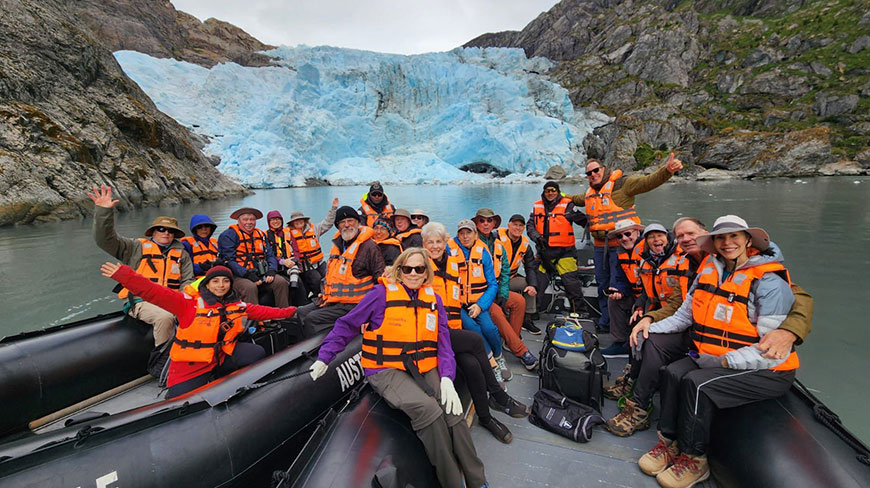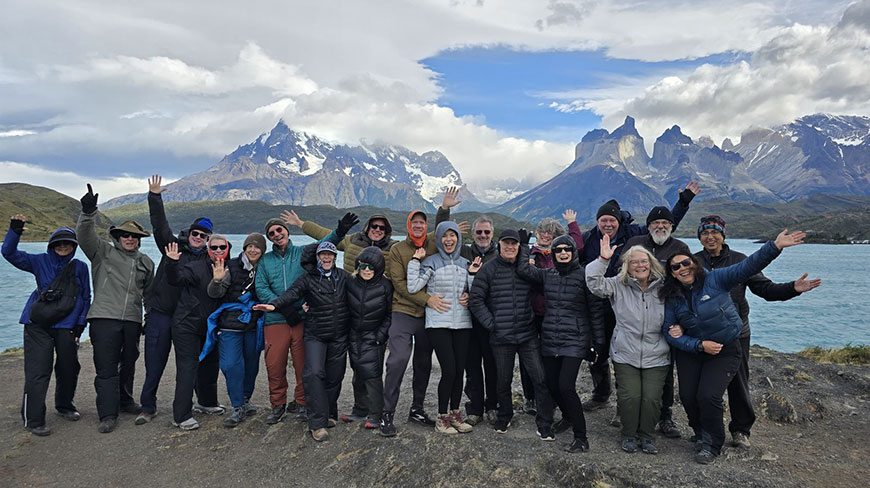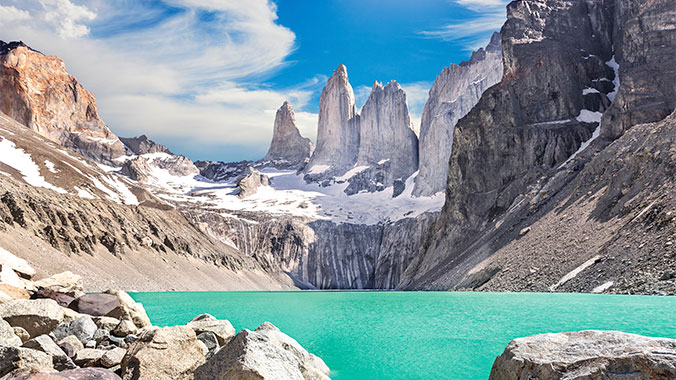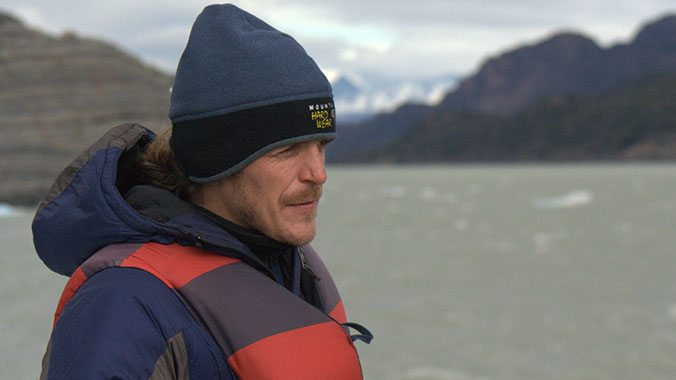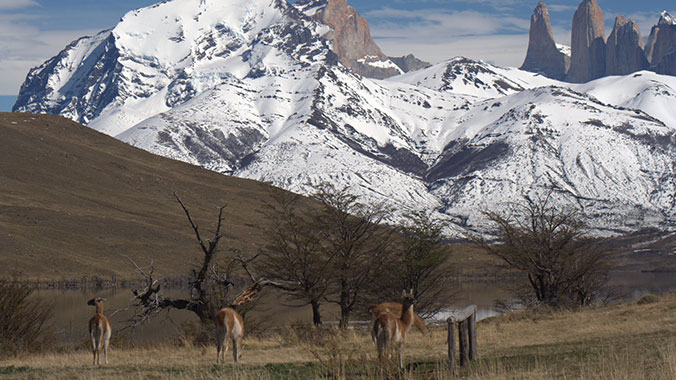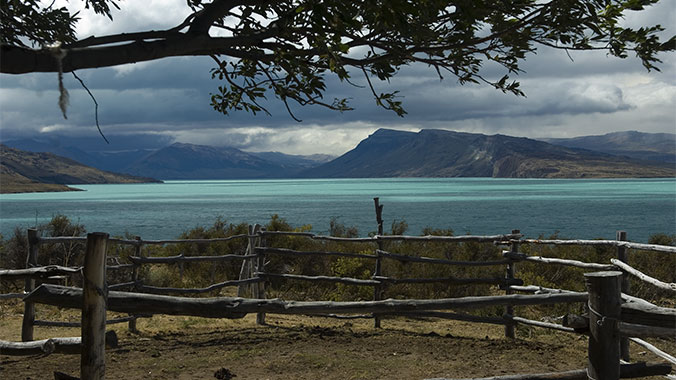Argentina/Chile
Finis Terrae: Exploring the Wilds of Southern Patagonia
Program No. 20614RJ
Based in the Patagonia Mountains, explore the natural wonders of South America, learning about geology, local flora and fauna and the story of this beautiful place.
Itinerary
While we make every effort to ensure the accuracy of our published materials, programs are typically advertised more than a year prior to their start date.
Read More.
While we make every effort to ensure the accuracy of our published materials, programs are typically advertised more than a year prior to their start date. As a result, some program activities, schedules, accommodations, personnel, and other logistics occasionally change due to local conditions or circumstances. Should a major change occur, we will make every effort to alert you. For less significant changes, we will update you during orientation. Thank you for your understanding.
Duration
15 days
14 nights
What's Included
34 meals (
12B, 11L, 11D
)
8 expert-led lectures
18 expert-led field trips
2 flights during the program
1 performance
An experienced Group Leader
13 nights of accommodations
Taxes and customary gratuity
Road Scholar Assurance Plan
Day
1
In Transit to Program
Location:
In Flight
Day
2
Buenos Aires, Orientation, Plaza de Mayo, Wine Tasting
Location:
Buenos Aires
Meals:
D
Stay:
725 Continental Hotel
Activity Note
Hotel check-in at 3:00 p.m. Early check-in can only be guaranteed by booking/paying for an additional night at the hotel. Those interested in reserving an additional night should contact the program provider at 1-800-866-7111 or roadscholarprograms@holbrooktravel.com for assistance. Walking throughout the city approximately 1/2 mile at a time on mostly flat, paved terrain.
Lunch:
This meal has been excluded from the program cost and is on your own to enjoy what you like. The Group Leader will be happy to offer suggestions and give directions.
Afternoon:
Orientation: 3:00 p.m. The Group Leader will greet everyone and lead introductions. We will review the up-to-date program schedule and any changes, discuss roles and responsibilities, logistics, safety guidelines, emergency procedures, and answer questions. Meals included in our program feature local cuisine. Aboard the ship, all meals are served buffet style including non-alcoholic and alcoholic drinks. Free time is reserved for your personal independent exploration. Evenings at leisure offer opportunities to make the program more meaningful and memorable through personal independent exploration, attending performances or other events on your own, or simply relaxing and making new friends among fellow Road Scholars. The Group Leader will always be happy to offer suggestions. Program activities, schedules, personnel, and indicated distances or times may change due to local circumstances/conditions. In the event of changes, we will alert you as quickly as possible. Thank you for your understanding. Next, we'll set off on an expert-led walking field trip through the Plaza De Mayo. We will begin by walking a little over a half mile in total from the hotel and around the historic site on the mostly smooth, paved streets of the city. The Plaza de Mayo is the main square of Buenos Aires and, from here, we will have the opportunity to see La Casa Rosada and La Catedral as well as other important historical monuments and buildings. We'll conclude our field trip at a local cellar/bar for a wine tasting activity and a chance to learn about some of Argentina's famed regional wines.
Dinner:
After the wine tasting, we will remain at the cellar where we will be served a plated meal and order from a select menu.
Evening:
After dinner we'll walk back to the hotel followed by time at leisure.
Day
3
La Boca, San Telmo, Recoleta, Tango Show
Location:
Buenos Aires
Meals:
B,L,D
Stay:
725 Continental Hotel
Activity Note
Getting on/off a bus: driving about 20 miles; approximately 2 hours total riding time throughout the day. We will be out late tonight in order to enjoy the Tango show, perhaps returning to the hotel around midnight. Participants who would like to return to the hotel earlier can take a cab from the venue.
Breakfast:
At the hotel.
Morning:
At the hotel, a local expert will set the tone for our day ahead by providing us with a class on the history and culture of Buenos Aires – the largest city and capital of Argentina. Afterwards, we’ll bring what we’ve learned to life by venturing into the city by bus while a local provides commentary along the way. During the city exploration, we will make stops at such significant sites as La Plaza de Mayo, La Boca, San Telmo, and Recoleta. Recoleta neighborhood is well known for the undeniable European influence in architecture and its impressive mansions. It is also famous for La Recoleta Cemetery, where some of the most wealthy and influential families in Argentina lie their family members to rest. This is the final resting place for the controversial former President and First Lady Juan and Eva Peron. We’ll also visit the vibrant La Boca neighborhood, a working class barrio rich with culture thanks to its central role in the city’s immigration story. This neighborhood is characterized by its distinctive, colorful buildings. Witness street performers dance tango throughout Caminito – a living street museum where artists sell their original work. Just six blocks from Plaza de Mayo lies San Telmo, one of the city’s oldest neighborhoods. San Telmo maintains the charm of the past complete with cobbled streets and original architecture from as early as the 17th century. This neighborhood is quickly becoming equally known for its new restaurants, bars, and artistic atmosphere with many artists and musicians moving to the area.
Lunch:
At a local hotspot, to sample a light Porteño-style meal.
Afternoon:
We'll ride back to the hotel and have a bit of down time before our next activities. We’ll reconvene with a local expert for a lecture on tango, a UNESCO List of Intangible Cultural Heritage in a hotel meeting room. Originating in the 1890’s on the border of Argentina and Uruguay, tango is a partner dance that is included in the UNESCO Intangible Cultural Heritage Lists. Immigrants came to South America in hopes of work and prosperity, but took to dance and music when these hopes did not become a reality. Combining South American and African culture with European influences, tango quickly spread throughout the region. Catching on in Paris and being adapted to a European audience, the dance soon reached all corners of the globe.
Dinner:
Depart for a local restaurant for dinner and a Tango Show. The origins of tango have been traced to working-class suburbs of Buenos Aires and Montevideo, Uruguay around the end of the 19th century. In this style of dance partners walk in unison to music speeding up their steps or slowing them down to convey different emotions. Typically, the dancers maintain their feet in close proximity as they walk and hold each other in a close embrace.
Evening:
Prepare luggage for check out.
Day
4
Flight to Ushuaia, Tierra del Fuego, Fuegian Dinner
Location:
Ushuaia
Meals:
B,D
Stay:
Cilene del Faro Suites & Spa
Activity Note
Getting on/off a bus; driving about 15 miles; approximately 0.5 - 1 hour riding time. The flight to Ushuaia is approximately 3.5 hours.
Breakfast:
At the hotel.
Morning:
Transfer to the airport to catch a flight to Ushuaia. Ushuaia is one of the southernmost cities in the world and the principal starting point for most expeditions to Antarctica. It is located on the main island in Tierra del Fuego, overlooking Ushuaia Bay and the Beagle Channel. Anglican missionaries moved to the area in the 1870’s and were the first foreigners to permanently live in the archipelago. Until then, the lands had been inhabited by the Yamana people (also called Yahgan). Sadly, the indigenous population began to decrease as more and more European immigrants moved to the area in search of gold, sheep farming opportunities, or missionary work. Not much is left of the Yamana these days, save the name Ushuaia; their name for the area meaning “the bay facing westward”.
Lunch:
Light snacks may be provided during the flight from Buenos Aires to Ushuaia. We recommend bringing snacks with you, which you may purchase the day before or at the airport just in case.
Afternoon:
Arrive to Ushuaia – Malvinas Argentinas International Airport, Ushuaia, Argentina. We will transfer and check into the hotel. In preparation for the upcoming adventures, we’ll attend a presentation led by a local expert introducing us to Tierra de Fuego and its history. In the region of Patagonia at the southernmost tip of South America lies the archipelago known as Tierra del Fuego (Land of Fire). It got its name after the 1520 expedition of Ferdinand Magellan when he and his sailors saw the distant smoke and fires of native peoples. Today, the territory is shared by Argentina and Chile and is known for the surrounding mountains, glaciers, and waterfalls. The southernmost headland of the archipelago is Cape Horn.
Dinner:
At the hotel, we'll learn about local ingredients of the region as we dine on typical Fuegian foods.
Evening:
At leisure. Prepare for hotel check out and embarkation on Australis cruise tomorrow.
Day
5
Tierra del Fuego, Maritime Museum, Embark Australis Ship
Location:
At Sea
Meals:
B,L,D
Stay:
M/V Ventus Australis
Activity Note
Getting on/off a bus; driving about 21 miles, approximately 1 hour riding time. Hiking about 2 miles over rugged terrain.
Breakfast:
At the hotel.
Morning:
This morning, we will drive to Tierra del Fuego National Park. Then we'll enjoy a walking field trip on park trails. Argentina's Parque Nacional Tierra del Fuego, located approximately 7.4 miles west of Ushuaia, was the country's first shoreline park. This park is home to incredible biodiversity including three southern beech varieties of deciduous trees: Nothofagus antarctica, Nothofagus pumilio, and the evergreen, Nothofagus betuloides. In these native forests, we just might have the opportunity to encounter guanacos and foxes in the mossy foliage. Short trails follow the southern edges of the park, providing visitors with scenic views of the Ensenada and Lapataia Bays, where you can reach the very end of the Pan American Highway and the famous Beagle Channel. A trail that leads west from Bahia Ensenada passes through an area of archaeological importance; grass covered shell mounds left by the Yamaná (a.k.a. Yahgan) inhabitants hundreds of years ago. Humans introduced beavers to the national park in 1946. During the visit, you may notice their dams throughout. You will notice that the entire area is surrounded by a breathtaking view of snowcapped mountains.
Lunch:
At a local restaurant.
Afternoon:
After lunch, we will pay a visit to Ushuaia's Maritime Museum. During the early 20th century, the Argentine government established a prison in Ushuaia, deciding that its remote location would make escape virtually impossible. The prisoners were used to build the town and establish a railway (now called the End of the World Train). Although the prison was closed in 1947, the buildings still remain and are now part of a naval museum. Visitors can still see some of the original structures built by prisoners while touring the older sections of the city. The museum displays include scale models of ships and historic information about Tierra del Fuego’s indigenous people and the European pirates and explorers who sailed to this remote part of South America. Transfer to Ushuaia's port to begin embarkation procedures on the Australis ship. Enjoy a cocktail reception hosted by the ship's captain and crew.
Dinner:
On board the ship.
Evening:
Ship departs from Ushuaia and sets sail.
Day
6
Cape Horn and Wulaia Bay
Location:
At Sea
Meals:
B,L,D
Stay:
M/V Ventus Australis
Activity Note
Cape Horn: ascend 160 steps, mostly without handrails then walk along a boardwalk without handrails to viewpoint. Approx. 1 hour. Wulaia Bay: moderate walk along forest paths approx. 1 mile, and 1.5 hours.
Breakfast:
On board the ship.
Morning:
This morning we will navigate through the Murray Channel and Nassay Bay on our way to Cape Horn National Park. We'll also enjoy a Group Leader presentation: Life at the End of the Earth.
Lunch:
On board the ship.
Afternoon:
Disembark at Wulaia Bay (weather permitting) for a walking exploration of Cape Horn National Park. Walk through a Magellanic forest of lengas, coihues, canelos, ferns and other native vegetation to reach a look-out point. Cape Horn is located in the southern part of the Tierra del Fuego Archipelago and is considered by most to be the southernmost point in South America. The gale force winds, strong currents, and unpredictable weather around Cape Horn make it especially challenging to sail these waters. This was an important route for trade ships until the Panama Canal was completed and began operating in 1914. Return to the ship.
Dinner:
On board the ship.
Evening:
At leisure.
Day
7
Pia Glacier and Porter Glacier
Location:
At Sea
Meals:
B,L,D
Stay:
M/V Ventus Australis
Activity Note
Pia Glacier: walking over rocky, uneven terrain for approx. 1.5 hours. Porter Glacier: no landing, Zodiac ride only.
Breakfast:
On board the ship.
Morning:
This morning the ship will navigate the Beagle Channel and Pia Fjord in preparation for activities around the Pia Glacier. Disembark near Pia Glacier. A short hike to a local lookout point will culminate in spectacular views of towering mountains and glaciers.
Lunch:
On board the ship.
Afternoon:
Once we're settled in our Zodiacs we will begin navigating the fjord towards Porter Glacier. During our journey we'll have the opportunity to admire the snowy peaks of the Darwin Range rising high above patches of temperate forest, coves, and even a couple of waterfalls. As we near Porter Glacier's craggy, blue terminus we will stop the engines to observe it while we learn about its history and how it continues to shape the landscape. If we are really lucky, we might hear and even see a calving event. Concluding our activities, we'll ride our Zodiacs back to the ship. Group leader lecture: Anecdotes from Darwin's Wanderings in Tierra del Fuego and Patagonia.
Dinner:
On board the ship.
Evening:
At leisure.
Day
8
Aguila Glacier and Condor Glacier
Location:
At Sea
Meals:
B,L,D
Stay:
M/V Ventus Australis
Activity Note
Aguila Glacier: easy walk over mostly flat terrain of sand and stone; slippery when wet. Walking about 2 miles; activity lasts approximately 2 hours. Condor Glacier: no landing, zodiac ride only; approximately 1 hour.
Breakfast:
On board the ship.
Morning:
Sail through the Cockburn Channel to Agostini Sound (a.k.a. Agostini Fjord) and its beautiful scenery. From this vantage point it will be possible to view glaciers flowing down from the mountains. Head to Aguila Glacier and disembark at a local beach. Admire the local landscape and acquaint yourself with the region's vegetation during an easy walk along the shoreline, ending at a viewing spot in front of the Aguila Glacier. Learn about Patagonia's cold rainforest and the powerful natural forces that helped shape the lands in this remote region.
Lunch:
On board the ship.
Afternoon:
We will hop into Zodiacs and near the Condor Glacier. If we are lucky, we will have a chance to see the Andean Condor, which frequents the area.
Dinner:
On board the ship.
Evening:
At leisure.
Day
9
Strait of Magellan, Magdalena, Disembark, Torres del Paine
Location:
Torres del Paine National Park
Meals:
B,L,D
Stay:
Hotel del Paine
Activity Note
Magdalena Island: easy walk over mostly flat paths of dirt; about 1.5 miles or approximately 1 hour in total. Camera extension poles are prohibited on Magdalena Island. Disembark approximately 11:30 a.m. Getting on/off a bus; driving about 154 miles, approximately 3 hours riding time to Puerto Natales; driving about 60 miles, approximately 2 hours riding time to Torres del Paine.
Breakfast:
On board the ship.
Morning:
Weather permitting, disembark at Magdalena Island located in the Strait of Magellan. A walk to the local lighthouse will take us past the island's large colony of Magellanic penguins. Magdalena Island was first declared a forest reserve in 1967, before being reclassified as a national park in 1983. The park is home to unique vegetation including fuinques, arrayáns, tiacas, female mañios, tineos, quilas, tepas, voquis, and coicopihues. Although resident Magellanic penguins tend to steal the show with their comical appearance and noisy antics, visitors should not overlook the island's other interesting inhabitants. Mammals found in the park include marine and river otters, guiñas, pudús, sealions, and fur seals. Bird lovers will not be disappointed-- Magdalena also has a rich avian population which includes petrels, cormorants, ducks, gulls, sandpipers, tyrant flycatchers, thrushes, and plovers. Return to the ship and set sail for Punta Arenas. Punta Arenas was originally set up directly on the sea, but later moved inland to a more hospitable spot along the Las Minas River. Once established, Punta Arenas grew as a port town and as a penal colony. Today, the city is vibrant and modern and serves as a gateway to both Tierra del Fuego and Patagonia--two regions notoriously rich in natural wonders. Disembark and transfer to Torres del Paine National Park.
Lunch:
At a local restaurant en route.
Afternoon:
Along the way, admire Patagonia's breathtaking scenery, framed by snow-peaked mountains and rolling plains dotted with guanacos. En route, we'll stop for a short break to have a coffee or a snack and stretch our legs. Upon arrival at the lodge in Torres del Paine National Park we'll check-in and have some time at leisure.
Dinner:
At the lodge, enjoy a buffet meal featuring Patagonian and Chilean regional cuisine.
Evening:
At leisure.
Day
10
Torres del Paine - Western Lakes
Location:
Torres del Paine National Park
Meals:
B,L,D
Stay:
Hotel del Paine
Activity Note
Walking about 2.5 miles, approximately 3 hours; undulating terrain.
Breakfast:
At the lodge.
Morning:
We will start this morning with a lecture: The Geological History of the Southern Andes. Next, we'll make our way to a beach along the shores of glacial Lake Grey. We will walk around Lake Grey to have a better view of the glacier.
Lunch:
Boxed lunch en route.
Afternoon:
By bus, we'll drive across Torres del Paine National Park enjoying views of Paine Grande and its snowy peaks, as well as Los Cuernos – the famous mountain with black granite horn-like spires. Walk along the shores of stunning Lake Pehoe and visit the furious Salto Grande Falls which pour the waters of Lake Nordenskjold into Pehoe. The walk continues over the gentle Nordenskjold trail until reaching its picture-perfect lookout point. Return to the hotel.
Dinner:
At the lodge.
Evening:
At leisure.
Day
11
Northeastern Torres del Paine
Location:
Torres del Paine National Park
Meals:
B,L,D
Stay:
Hotel del Paine
Activity Note
Driving approximately 3 hours throughout the day; walking up to 3 miles, about 2.5 hours.
Breakfast:
At the lodge.
Morning:
We will start this morning with a lecture on the animals of the Southern Andes. Then, we'll board our bus and drive towards Laguna Azul, in the northeastern side of the national park. Stop to take photos of the gorgeous landscapes and the local flora and fauna along the road, including a stop at Paine Waterfall. Once at Laguna Azul, hike to a lookout point where there is a panoramic view of the lagoon and the famous granite towers that give the park its name.
Lunch:
Picnic-style meal.
Afternoon:
We'll continue our exploration of Torres del Paine with an easy trek along Cañadon Macho. On our way back to the hotel, we'll enjoy panoramic views of Cascada Paine, Rio Paine, Lake Pehoe and Paine Massif. After this activity, we will return to the lodge to relax before dinner
Dinner:
At the lodge.
Evening:
At leisure.
Day
12
Transfer to Puerto Natales, Milodon Cave, Fly to Santiago
Location:
Santiago
Meals:
B,L,D
Stay:
Pullman Santiago Vitacura Hotel (ex Atton)
Activity Note
Getting on/off a bus; driving about 65 miles, approximately 2 - 2.5 hours riding time. The flight to Santiago is approximately 3.5 hours. PLEASE NOTE: The departure location is determined by the available air schedules and flight times. If the flight from Puerto Natales is not operating we will drive to Punta Arenas and then take a flight to Santiago.
Breakfast:
At the lodge.
Morning:
We say farewell to Torres del Paine and begin the transfer to the airport. En route, we will visit the Monumento Natural Cueva de Milodon; a massive prehistoric cave where the remains of a giant ground sloth were discovered in the 1890s. The site is located in a transition zone, where forests and arid plains meet, and is home to a large number of bird species.
Lunch:
We’ll stop to pick up our lunch from a local restaurant and enjoy it on the road en route to the airport.
Afternoon:
Upon arrival to the airport, we'll disembark the bus for check in procedures. Afternoon flight to Santiago. When we arrive in Santiago, we will be met at the airport and transferred to the hotel. We’ll check in and get our room assignments.
Dinner:
At the hotel in Santiago.
Evening:
At leisure.
Day
13
Plaza de Armas, Pre-Columbian Museum, Local Cuisine
Location:
Santiago
Meals:
B,L
Stay:
Pullman Santiago Vitacura Hotel (ex Atton)
Activity Note
Getting on/off a bus; driving about 10-15 miles, approximately 1 hour riding time. Walking up to 2 miles; some stairs, mostly flat, paved terrain.
Breakfast:
At the hotel.
Morning:
At the hotel we'll attend an expert-led presentation on the role of Chile in South America. A country that is rapidly growing and expanding, the country’s politics and economy are changing and revealing the potential to become a strong, regional player. After boarding a bus to Santiago's historic city center we'll disembark and begin our explorations on foot. As we make our way through the grand Plaza del Armas and the Pre-Columbian Museum, our Group Leader will offer insights into the cultural and economic influences that helped shape the growth and development of the Chilean capital. Next, we will walk a few blocks from the Pre-Columbian Museum to a restaurant at Las Tarrias neighborhood.
Lunch:
At a local restaurant.
Afternoon:
Next, we will ride and walk up Santa Lucia Hill to enjoy panoramic views of the city while we learn about the founding of Santiago. Concluding our activity, we'll board the bus and ride back to the hotel.
Dinner:
On your own to try local specialties.
Evening:
At leisure.
Day
14
Winery, Farewell Lunch, Program Concludes
Location:
In Flight
Meals:
B,L
Stay:
Pullman Santiago Vitacura Hotel (ex Atton)
Activity Note
Getting on/off a bus; driving about 65 miles, approximately 1.5 hours riding time. Hotel dayroom only - check-out is at 6:00 p.m. Evening flights to the U.S. See your program’s "Getting There" information regarding transfers.
Breakfast:
At the hotel.
Morning:
We will board a bus and ride to a local winery located just outside of Santiago. At the winery, a local expert will speak to us about the local viniculture before we enjoy a wine tasting. Chileans have produced fine wines for over a century, although the conquistadors also planted vines. The origin of today's world-class Chilean wines stems from cuttings brought over from French vineyards in the mid-19th century before their stock was decimated by disease. Later, the European vines were grafted onto disease-resistant American stock. Chilean growers, however, had the advantage of original, non-grafted vines from France as well as an ideal climate in the Central Valley. Chilean wines are becoming more and more popular around the world as they continue to win prizes at prestigious international wine tasting competitions.
Lunch:
Farewell lunch at the winery.
Afternoon:
Return to the hotel, followed by some "down time" to get some rest, enjoy hotel amenities, and/or do some last minute packing. Late afternoon refreshments at the hotel before heading out to the airport to catch international flights to the U.S.
Evening:
Transfer to the international airport to catch overnight flights to the U.S. This concludes our program. If you are returning home, safe travels. If you are staying on independently, have a wonderful time. If you are transferring to another Road Scholar program, detailed instructions are included in your Information Packet for that program. We hope you enjoy Road Scholar learning adventures and look forward to having you on another rewarding program in the future. Don’t forget to like our Facebook page and follow us on Instagram. Best wishes for all your journeys!
Day
15
Arrivals in the U.S.
Location:
In Flight
Please select a day to update the map
Map details are not available for this location.
Please Note:
This program has itinerary variations on certain dates.
Mar 8 - Mar 22, 2027 Itinerary Differences:
This date will be accommodated on the M/V Ventus Australis. Please refer to your detailed program itinerary for more details.

